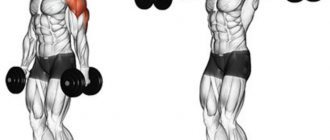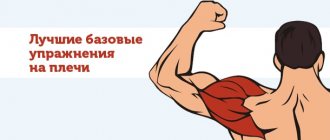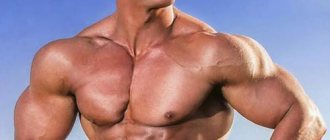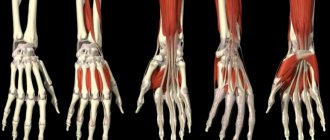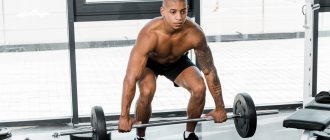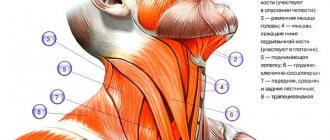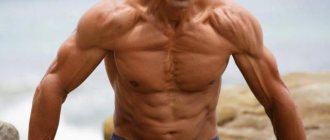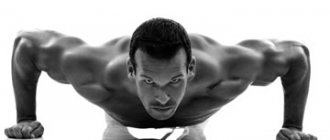Author of the article
Andrey Belozertsev
Drawing up programs for effective muscle mass gain.
The shoulder girdle is an extremely important muscle group, as it is involved in almost all movements performed in the upper body.
Plus, impressive shoulders are just beautiful.
Unfortunately, for many this part of the body is the least developed.
Push-ups are a great way to combat this problem.
They are not only effective, but also affordable: they can be practiced without special equipment and at home.
You will learn how to pump up your shoulders with push-ups using different types of this exercise.
Can you get really big shoulders at home with push-ups?
Developing the large shoulder muscles requires commitment to a strength training plan that includes several types of exercises. Push-ups work your shoulders and chest muscles, strengthening your entire upper body. However, doing push-ups alone will not help you achieve maximum shoulder growth results. Push-ups primarily work the pectoral muscles. And the deltoids and triceps muscles are the secondary engines in push-ups. Push-ups increase the size and strength of your deltoids, making your shoulders appear wider.
Push-ups are performed in several variations, each with a different impact on the shoulders. Below are modifications of the exercises and the muscles involved. You will learn how to pump up your shoulders at home with push-ups. But there is a huge disadvantage to these workouts - with push-ups you can pump up the anterior deltoid to a greater extent. If you can easily do push-ups upside down, you can also pump up the middle fascicles of your shoulder. But the rear delt is not included in any of the push-up variations. Therefore, why develop your shoulders unevenly. Push-ups can only become an addition for the deltoid muscles in home workouts to the main complex with weights, but cannot replace a full-fledged program for the deltoids.
Since push-ups are bodyweight work, you won't be able to add additional stress like you should when working to increase muscle mass. Consequently, your strength and the number of repetitions you perform will increase. This will not help you get bigger shoulders. The number of repetitions should start from 8 to 12. If you do a lot more push-ups, then you will only increase endurance, but not volume. You can pump up your shoulders with push-ups at home, but only if you work with both dumbbells and a barbell.
Contraindications
Push-ups will have a different impact for everyone and this is worth taking into account. Some will benefit from increased shoulder size and strength, but for others it can lead to serious health problems. It is strictly forbidden to do push-ups when:
- high blood pressure, the peculiarity of body position will only further increase this indicator;
- problems with joints and tendons, exercises of this type will create additional stress and aggravate the situation;
- overtraining of the body, a large number of approaches can cause catabolism.
And even in a normal state of health, you shouldn’t overuse training too much, everything should be in moderation.
How to pump up your shoulders with push-ups?
Let's look at how to pump up your shoulders with push-ups, working mainly with the front and middle beams.
It is important! Carefully monitor your body position when performing push-ups to increase the size of your chest and shoulders. Doing a small number of high-quality push-ups is a more effective way to train at home, as opposed to doing a large set of push-ups with poor technique. Using incorrect arm position or misalignment of the hips and back can result in injury. Stop immediately if push-ups cause severe pain or damage your joints. Consult a personal trainer to make sure you are doing everything right.
Upside down push-ups against a wall
This technique will show you how to do push-ups to pump up your shoulders. This is a difficult way to train at home, as it requires preparation for physical activity and control of the whole body. The exercise is performed in a vertical stance against a wall.
- Perform a handstand with your hands wide apart. Touch the wall with your feet for support;
- As you inhale: lower your head to the floor, bending your elbows to the sides, bringing the angle at your elbows to 90 degrees;
- As you exhale: push up with the strength of your arms, returning to straight arms.
- Do not perform more than 12 repetitions. After resting, repeat 3 more sets.
Semi-vertical push-ups
A simplified version of vertical push-ups pumps the front muscles and reduces compression in the shoulder joints. It is performed by raising the feet above the body using a bench or chair, in which the body reaches an inclination of 50 degrees.
- Place your feet on a bench, palms on the floor wider than your shoulders;
- Inhale: lower your chest to the floor, bending your elbows to the sides at a right angle;
- Exhale: push up to the starting point.
Corner push-ups
This push-up variation works the front and middle deltoid muscles. The corner technique is a modification of vertical push-ups, and lightens the load by reducing body weight and supporting the legs on a hill. Do not forget to breathe correctly; exhalation is always done with effort.
- Place your feet on a bench, chair or bed, palms wide apart on the floor;
- Move your hands closer to your legs, drawing a right angle between your torso and the berms. Pelvis over shoulders;
- Inhale: bend your elbows, moving them to the sides, your head tends, but does not touch the floor;
- Exhale: do push-ups with your arms straight.
Narrow push-ups
In this option, only the front deltas are trained. You can perform push-ups from the floor or with your palms on a bench - this option will simplify the technique with greater tension in the chest and triceps muscles.
- Place your palms under your shoulders in a prone position;
- Inhale: lower your chest to the floor, bending your elbows along your torso;
- Exhale: using the strength of your arms and chest, push yourself to the original position.
Reverse push-ups
This technique will show how to pump up your shoulders with push-ups if you don’t have special weights. Push-ups work the chest, shoulders and triceps, or more precisely the front deltoids.
- With your back to the bench, place your palms on the edge under your shoulders;
- The knees can be bent; to make it more difficult, the legs can be straight, with the heels touching the floor;
- Inhale: bending your arms, elbows go back, taking an angle of 90 degrees;
- Exhale: push off and rise with effort, leaving your pelvis hanging.
Tips and tricks for training
In order for the impact on the shoulders to be correct, you should adhere to a number of recommendations, because the exercises have their own nuances:
- The higher a person lifts their torso during push-ups, the more emphasis is placed on the shoulders, especially the triceps.
- There is no need to spread your elbows to the sides. This could result in serious injury.
- For safety, you need to place your palms slightly wider than your shoulders. In this situation, the person will not be physically able to move his elbows to the sides.
- You need to raise your torso until your arms are in a straight position, but at the same time the elbow area should be relaxed.
Beginner athletes are not recommended to wear weights. Their own weight is enough for them. It is also important to monitor the amplitude of the descent to the ground. Experts recommend reducing by half the body's capabilities, and as muscles grow, you can increase your goals.
How to accelerate the growth of deltas with the help of sports nutrition?
It is known that nutrition accounts for almost 80% of success in muscle growth. And one of the most important techniques during the mass gain period is the consumption of food after training. We must not forget about this! What happens after the load? During training, you reduced muscle fibers as much as possible, thereby damaging them, and spent a lot of energy on this. Nutrients received after training nourish and fill micro tears in the muscles, providing all the necessary substances for muscle growth, as if “building” new muscle fibers. Therefore, do not ignore closing the so-called “protein-carbohydrate” window.
It follows that muscles need amino acids to build new cells, as well as carbohydrates to replenish energy reserves. If you skip this technique, the muscles will begin to “burn”, eating themselves, since protein for recovery will be taken from the muscles, because you have already spent glycogen (glucose) during training. Therefore, you can only harm yourself. Make it a rule to eat after each workout, but no later than 40 minutes after it ends.
So, you need fast carbohydrates, protein (protein) with a rich complex of amino acids, both essential and essential. It will be difficult to imagine this portion of food, specially brought into the gym, lying there throughout the entire training session, waiting for the “window”. Manufacturers of sports nutrition have simplified this task to the point of impossibility. It’s much easier to dilute the gainer in a shaker with water and get a complete protein-carbohydrate balanced cocktail that your muscles need. Moreover, one serving will completely replenish the norm of proteins and carbohydrates during this period.
In order not to force yourself to wait long for the growth of beautiful and rounded deltas, take a can of gainer and take it after a workout or at a time when you cannot eat properly. Hunger will only hinder growth. And you can’t do without a complex of complete cycle and essential amino acids (BCAA). The latter, with complex chains, are not produced by the body’s own, therefore, replenishment is needed from the outside. BCAAs will prevent catabolism during exercise and after sleep, when all glycogen stores have been burned and further loss of muscle protein is possible. To do this, take the complex immediately upon waking up and half an hour before exercise. Full cycle amino acids should be taken after training and at night.
For those who are just deciding whether they need sports nutrition, we recorded a video below:
We recommend: a trusted sports nutrition store, where they will make a selection for you according to your goals!
T-push-ups
The addition of a rotational component strengthens the shoulder muscles by constantly changing the point of contact with the ground.
They strengthen the shoulder ligaments, stretching the thoracic spine:
- perform push-ups;
- lift one hand off the floor and roll over into a side plank, raising your arm up;
- follow the raised hand with your eyes, keep your abs tense;
- return to the lying position and repeat the push-up.
Do the same number of repetitions with rotation in one direction and the other.

